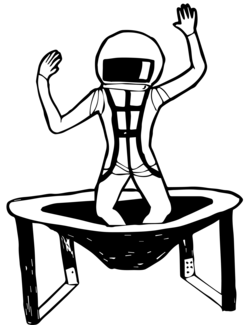Phenomena in Weightlessness
Some people may find it hard to imagine that research in weightlessness can be done not only in space, but also on Earth. Still, it happens every day in the Bremen Drop Tower and up to 20 times an hour in the GraviTower Bremen Pro. When there is only one millionth of the Earth's gravitational pull, a wide variety of phenomena can be investigated that are not visible under normal gravitational conditions. But what is being studied and why is research in microgravity so relevant to us?
What is being researched?
Scientific teams from all over the world come to Bremen to use the Drop Tower and the GraviTower for their research. Experiments range from astrophysics, biology, chemistry, combustion research, fluid mechanics, materials science to fundamental physics. Interested in some examples?
Some of the experiments in microgravity are directly related to space exploration: technologies or specific hardware are tested that will later be used in space missions. For the MASCOT lander, which successfully landed on an asteroid in 2018, tests were carried out in the Drop Tower to determine how the lander would separate from the probe. Another important area of research is the behavior of fluids in weightlessness. This is relevant to issues such as the refueling of spacecraft or the operation of life-support systems. As we get closer to the idea of sending an astronaut to Mars, scientists are also looking more closely at issues such as plant growth under altered gravitational conditions.
However, the absence of gravity is also ideal for fundamental research. It benefits greatly from being able to study physical processes for short periods of time without the "disturbing factor" of gravity. This is the case, for example, for a research group at ZARM, which is part of a large German research consortium. They are generating the "Bose-Einstein condensate" in microgravity for much longer than would be possible under normal laboratory conditions.
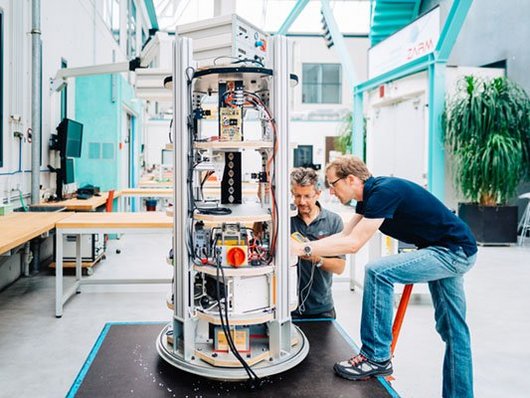
What kind of research is being conducted in microgravity?
What exactly is going on in the Bremen Drop Tower?
With a height of 146 meters, the Bremen Drop Tower is ZARM's most impressive laboratory, having provided the opportunity to carry out short-term experiments under weightlessness since 1990.
In order to perform an experiment, scientists are using a simple principle of physics: In free fall all bodies are almost weightless.
The drop capsule, in which the experiment takes place, is either pulled up and dropped into the airless drop tube, which is about 120 meters high. Or the capsule is shot up by the world's only catapult system to just below the top of the drop tube.
The Drop Tower in Bremen is the most successful microgravity laboratory in the world because researchers can benefit from consistently excellent conditions: Up to three times a day, experiments are subjected to weightlessness of just one millionth of the Earth's gravity. This exceptional quality is achieved because the free fall takes place in a vacuum. Before a microgravity experiment is carried out, 18 high-performance pumps create a vacuum in the 120-metre drop tube, eliminating air resistance. The catapult system, installed in 2004, allows experiments to last for 9.3 seconds – a world record.
Would you like to conduct an experiment in the Drop Tower? Please click here.
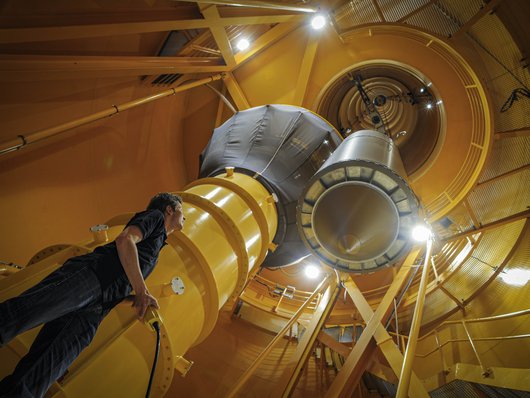
Videos about the Bremen Drop Tower
The GraviTower Bremen Pro
The GraviTower provides scientists with a completely new type of (space) laboratory. Thanks to innovative technology, it offers the possibility to perform scientific experiments under microgravity conditions up to 20 times per hour.
The GraviTower uses a rail system to carry out the experiments. Its special feature: a cable drive accelerates a slider carrying the experiment capsule to exactly the speed it would theoretically reach during a catapult flight in the vacuum of the Drop Tower.
The GraviTower does not need a vacuum, because the air resistance is compensated by a cable drive. The experiment capsule is shielded from ambient air by the slider. When reaching the microgravity phase, the capsule is uncoupled from the slider. It is then in free fall as a contactless object for 2.5 seconds. During this time, there is no air movement inside the slider that would slow down the free fall of the capsule, so we achieve a similar quality of weightlessness as in the Drop Tower. Towards the end of the free fall, the capsule is re-coupled to the slider and both are decelerated by the cable drive.
Up to 20 experiments per hour can be carried out daily within the GraviTower. After each individual catapult flight, the scientists can access the experiment, vary the experiment setup or analyze the data collected. This combination of very high-quality microgravity and direct and unrestricted access to the experiment after each 2.5 second flight is unique.
But that's not all: the acceleration provided by the cable drive allows the test capsules to be subjected not only to weightlessness, but also to the gravitational conditions of the Moon, Mars and other planets or celestial bodies. For example, to test equipment for Mars missions, the GraviTower provides one third of the Earth's gravity (1/3 g) during the experiment, corresponding to the gravitational force on Mars.
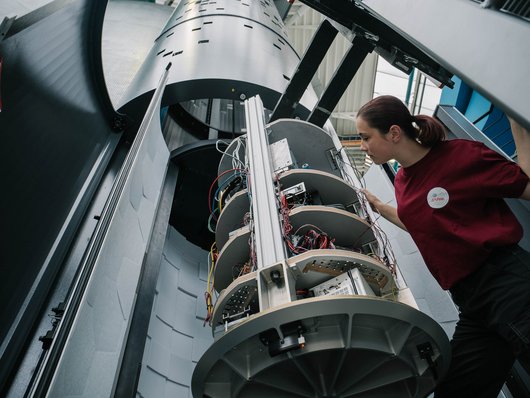
Videos about the GraviTower Bremen Pro
The Gravity of the Situation – What is Weightlessness and Why Does It Matter
Gravity acts on all objects in the Earth's orbit and ensures that when an apple falls from a tree, it lands on the ground. (Or: a slice of toast lands on the floor when it falls from our hands.) How can we still be weightless on Earth?
Gravity is a universal physical force that acts between masses and manifests itself as a force of attraction. It is the force that holds our solar system together, determines the orbits of the planets, and is responsible for all bodies on Earth falling toward the center of the Earth, i.e., toward the ground. Earth's gravity affects all of us – all of the time. We take it for granted.
The greater the mass of a body, the greater the gravitational force it exerts. Accordingly, all bodies have a specific gravitational pull. Our Earth has a gravitational pull ("force per mass") that is described as 1 g (g corresponds to about 9.81 m/s²). But what happens to bodies when there is no or very little gravitational force acting on them, or when the effect of the gravitational force is minimized by the influence of other forces? This phenomenon is called weightlessness or, more precisely, microgravity. The gravitational force is close to 0 g. Weightlessness can be observed, for example, on the ISS or on satellites orbiting the Earth. For experiments in the microgravity laboratories at ZARM, scientists use the principle of free fall to conduct research under conditions of weightlessness.
The Science of Falling Freely
A falling body is in a state of weightlessness because gravity causes it to move at an accelerated rate without the effect of a counterforce. It is weightless precisely when gravity acts on it unhindered. Thus, what we perceive as "gravity" is our accelerated body being pulled towards the center of the Earth and stopped by the counterforce of the Earth's surface. On the other hand, when we are in free fall, we cannot feel our weight because there is no counterforce. This means that we not only feel "weightless" – we almost are.
The effect of weightlessness is not limited to a vertical free fall. Even if you throw a ball into the air and it falls to the ground in a parabolic arc, it is weightless for most of the distance. The effect of weightlessness therefore has the same effect on an object that is on its way up due to previous propulsion as it does on an object that is on its way down due to gravity.
The Equivalence Principle
It may come as a surprise, but in principle all bodies fall at the same rate. The principle of equivalence states that on Earth – in a vacuum – all objects fall at exactly the same speed. Although a feather falls slower to the ground than a hammer, this is due to the frictional forces between the bodies and the medium surrounding them (here on Earth, mostly air). Because of its larger surface area, the air slows down a feather more than a hammer. Therefore, the hammer falls faster.
For researchers, the decelerating effect of the surrounding air is a problem that must be avoided when conducting experiments in weightlessness. Otherwise, the results of their experiments would be distorted. The solution: Either they prevent frictional forces by performing the experiment in a vacuum – as in the Bremen Drop Tower. Or they accelerate the free fall through the air – as with the rail system of the GraviTower.
Videos on the physics behind the magic
FUN FACTS ALL AROUND THE DROP TOWER
Curious about some exciting facts about the Drop Tower that you haven't heard yet?

Animal Inhabitants of the Drop Tower
Even if you don't see them all the time, the Drop Tower in Bremen often has animal inhabitants: At a height of 100 meters there is a nesting box that is usually inhabited by peregrine falcons. This means that the building is automatically part of the falcon's hunting grounds. On some days, if you are lucky, you can see them on the outside railing of the drop tower.

Art in the basement
With the title ZARM - ZentralAlarmRuheMasse the German artist A.R. Penck together with his Irish colleague Felim Egan immortalized themselves on the walls of the then empty catapult cellar of the Bremen Drop Tower in 1995.
The Drop Tower swaying in the wind
Could the Drop Tower really topple over when a strong storm hits Bremen? Don't worry about it! The Hanseatic weather conditions were taken into account during construction. In fact, weather protection is the main function of the Drop Tower, as the striking building only serves as a protective cover for the drop tube inside. In strong winds and gusts, the tower can sway up to 10 centimeters in any direction. However, because the tower touches the inner tube only at its base, this has little effect on the tube. Experiments in catapult mode are possible in any weather. In drop mode, the experiment operation will be interrupted when the wind speed reaches 16 meters per second.
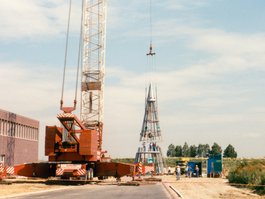
The Drop Tower Top
Did you know that there is a room at the top of the Bremen Drop Tower? The crowning glory in the construction of the Drop Tower was the glass top of the Drop Tower, which was placed on top of the tower using Germany's largest crane. Today it houses our Panorama Lounge. Due to strict safety regulations, access to the top of the Drop Tower is restricted. However, the rooms can be booked for weddings, small events as well as for business meetings on request.
Still curious about the Bremen Drop Tower? ZARM offers various types of guided tours.
You can find more information here.




